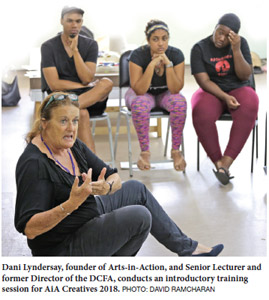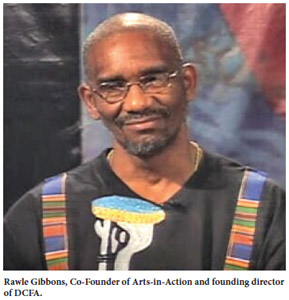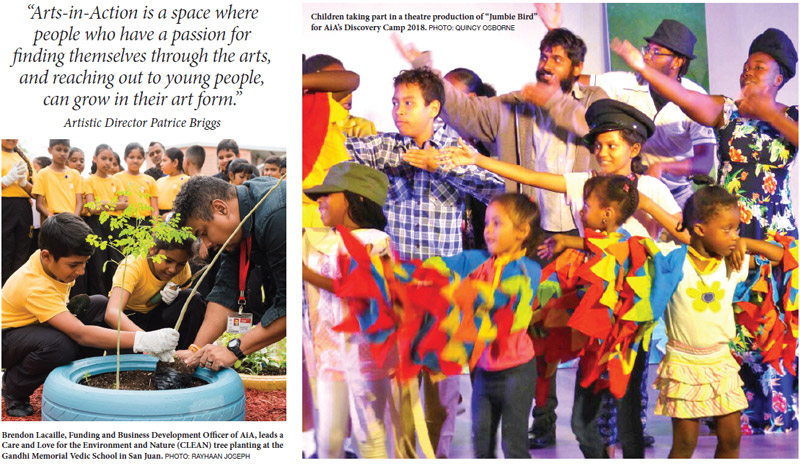
When she first moved to Trinidad and Tobago with her Trini-born husband Dexter, Australian native Dani Lyndersay already had experience under her belt in the field of arts activism. She had worked in Theatre in Education in Nigeria.
Their T&T arrival happened to coincide with the aftermath of the 1990 attempted government overthrow by the Jamaat al Muslimeen. Then-Culture Minister Joan Yuille Williams, noting how many young people had been caught up in looting and other nefarious activities, made a call for youth programmes and plans of intervention. It was from this moment of societal trauma that Arts in Action would eventually emerge.
Founded by Lyndersay in 1994, Arts in Action (AiA) has made its reputation as the leading “applied creative arts” company in the Caribbean. In 2019 they are celebrating 25 years of public education and social intervention through the arts.
Creative intervention
A Senior Lecturer and former Director of the Department of Creative and Festival Arts (DCFA), Lyndersay recalls those early days before AiA was created. She put together “Youth Crossroads”, a tour of community centres using drama workshops to engage young people and their communities.
“I needed work,” she says, “and I am a very good nag!”
Lyndersay was able to secure donations for fabric, instruments, paint and other materials to get the initiative going. However, following elections and a change in government, the programme fizzled.
Later, working at the DCFA, Lyndersay moved to create a new programme that would use theatre, dance, music, visual arts, storytelling, spoken-word, Carnival Arts, and others to help create social change. Teaming up with then-DCFA Head Rawle Gibbons, Theatre Arts lecturer Ken Joseph and the late Brian Honore (of Midnight Robber fame), Lyndersay birthed (AiA).
From humble beginnings based at a desk at the library of the old Creative Arts Centre on Agostini Street, the programme now has its own office at the DCFA at the Gordon Street campus. Posters about their work and several commendatory certificates line the walls, including and EMA Green Leaf Award and, from the university, the Vice Chancellor’s Award for Excellence.
From this base, AiA seeks to extend the work and mission of the organisation into communities and institutions in T&T and the Caribbean.
The programme is project-based. They work with institutions, primary and secondary schools, communities, private companies and other organisations to find solutions to diverse issues through artistic activities.
Core members include Artistic Director Patrice Briggs; Artistic Programme Manager Brendon Lacaille; and Artistic Networking Officers Camille Quamina and Marvin George, both currently lecturing at the School of Drama at Edna Manley College of the Visual and Performing Arts (where George is Dean) at The UWI Mona Campus in Jamaica.
Briggs, also a DCFA lecturer and an early recruit of the programme, remains enthusiastic about the mission, which draws from the student population for personnel.
“Arts in Action is a space where people who have a passion for finding themselves through the arts, and reaching out to young people, can grow in their art form,” she says.
Like many participants, she got involved with AiA as a UWI student. While doing a double major in English Literature and Theatre in 1998, she joined the team and hasn’t looked back.
 She says AiA encounters “many students who are not necessarily studying the Arts,” but through their interaction “the truth of their passion is revealed to them”. She says AiA encounters “many students who are not necessarily studying the Arts,” but through their interaction “the truth of their passion is revealed to them”.
When asked to intervene in a problematic situation, she says, first: “we ask, ‘what is the need?’ We research it. We talk and create an interactive presentation. We speak the truth about the issue at hand.
“People also come to start up their arts business – because it is a business,” she says. Their programmes show practitioners how to turn their passion into sustainable ventures.
It is a lesson AiA learned early. They could not survive relying on external funding: “We have to see about ourselves and stand on our own feet.” The organisation, though sometimes sorely challenged by a lack of financial resource, is fully self-funded.
“We realised when we reached our 13th year, people don’t normally last this long doing what we do. But we have found a way. If this is the work you want to do, it is viable.”
She describes AiA as “the outreach arm” of the DCFA. Lyndersay stresses that the programmes they create are tailored to the needs of each client and based on research, “so that it resonates”.
Lyndersay explains that the work is not about dispensing solutions, but rather helping clients understand issues and work out their answers for themselves through the process.
“It has to be interactive. You are responsible for your life. In figuring out how to help effect change, we sing, write, and dance about it.”
Lacaille, who joined around the same time as Briggs, feels it is AiA’s unique Caribbean essence that truly speaks to, engages and empowers communities, as they are able to see themselves.
“Whether it is Carnival characters or Ramleela, the work takes the community into account,” he says.
He feels the power of the Arts is under-appreciated: “Theatre does not just play a supporting role in making change. It is the vehicle for transformation.”
.
Dealing with issues “from the point of view of the community and through their interactive performance workshops,” he says, “people find meaning”.
 The workshops challenge the audience to seek positive ways of achieving mindset, attitude and behaviour change. The workshops challenge the audience to seek positive ways of achieving mindset, attitude and behaviour change.
Unlike “a show where you just look and clap,” Briggs says, AiA’s productions must involve the audience.
And unlike full productions, AiA takes a minimalistic approach to sets and costuming, using cubes, boxes, and symbolic items to represent the reality being examined. “We ask the audience to use their belief,” Lyndersay says.
And through their belief in their mission, it continues to grow, in spite of persistent ongoing areas of need. Their wish-list includes a better-equipped home for their work and a proper theatre hall at the university, instead of the multi-purpose halls which do not have proper backstage areas and other performance-specific requirements. A designated messenger with a dedicated AiA vehicle is also needed.
Lacaille feels the university should take a leading role in helping the public to value DCFA’s work. “If UWI demonstrates how the arts should be treated, people will follow.”
On their 25th anniversary, he says “we want to honour the work that has gone before.”
To celebrate their milestone, AiA has lots in store. From September 20 to 22, they will host a major symposium at the DCFA, entitled “Applied Arts in Action”, examining the educative arts in the region.
They will hold their annual arts-based Discovery Camp for children five to 13, which staged a full production called Jumbie Birds last year. They have also been asked to train performers by the National Ramleela Council of Trinidad and Tobago.
Energy company BHP Billiton has commissioned AiA for an anti-bullying project for North-East and South-East schools. They are also working with the Citizens for Conservation on behalf of “at risk” youth. And they are hosting AiA Creatives, a series of quarterly experimental workshops for degree students.
And so the work is ongoing, but so are the challenges – and the inspiration.
“It never stops,” says Lyndersay. “We can’t stand still.”
“That’s the beauty of the arts. It is eternally new.”
More information on Arts in Action is available at artsinaction.org.

Gillian Moore is a writer, editor and singer-songwriter.
|





